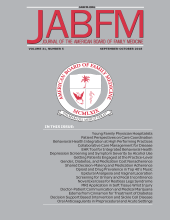Article Figures & Data
Tables
Team Role: Core N Social worker 37 Registered nurse 33 Physician/geriatrician 32 Clerical associate 25 Licensed practical nurse 24 Pharmacist/clinical pharmacist specialist 23 Team Role: Extended N Dietician 14 Psychologist/geropsychologist 14 Nurse practitioner 12 Other unspecified 7 Speech or language pathologist 4 Clinical registered nurse specialist 3 Physician assistant 2 Health administrator 2 Occupational therapist 2 Physical therapist 2 Nurse aide 1 Chaplain 1 - Table 2.
Distribution of Geriatric Patient-Aligned Care Team Member Full-Time Employment Equivalent
Team Role: Core Mean FTEE SD Min Max N Physician/geriatrician 0.73 0.39 0.08 1.50 33 Registered nurse 0.71 0.33 0.07 1.00 29 Licensed practical nurse 0.75 0.45 0.08 2.00 19 Clerical associate 0.56 0.34 0 1.00 23 Social worker 0.43 0.35 0 1.00 32 Pharmacist/clinical pharmacist specialist 0.35 0.32 0.01 1.00 26 Team Role: Extended Mean FTEE SD Min Max N Nurse aide 1.00 - 1.00 1.00 1 Nurse practitioner 0.77 0.48 0 2.00 17 Clinical resident nurse Specialist 0.59 0.37 0.30 1.00 3 Physician assistant 0.50 0.41 0 1.00 4 Occupational therapist 0.38 0.48 0 1.00 4 Physical therapist 0.38 0.48 0 1.00 3 Health administrator 0.31 0.09 0.25 0.38 2 Psychologist/geropsychologist 0.26 0.29 0 1.00 12 Dietician 0.24 0.30 0 1.00 9 Psychiatrist/geropsychiatrist 0.20 0.26 0 1.00 12 Speech or language pathologist 0.08 0.14 0 0.25 3 FTEE, full-time employment equivalents; SD, standard deviation.
- Table 3.
Most Commonly Reported Patient-Aligned Care Team Practices Used in Geriatric Patient-Aligned Care Team (N = 36)
N Access and Scheduling (average practices implemented = 6.89/10) provides non-face-to-face clinical guidance to patients 36 schedules each patient with a personal clinician except when the clinician is unavailable 35 provides a same-day appointment if clinically indicated, excluding emergency department 31 Care Coordination (average practices implemented = 17.9/22) reviews information received from other facilities to identify what follow-up support a patient needs 36 assesses barriers when patients do not move toward their treatment goals (eg, medication adherence, costs of care, and lack of family support). 35 incorporates external records into the practice chart 35 reviews charts in advance of visits to anticipate patient needs 34 Population Management (average practices implemented = 8.05/13) incorporates evidence-based guidelines into everyday workflows for important conditions seen by Geriatric Patient-Aligned Care Team 32 identifies patient on particular medications who need monitoring or evaluation and reminds them of this need 28 identifies patient who might benefit from additional coordination/care management services and contacts them about these options 27 Care Processes (average practices implemented = 11.38/20) involves patients in their own decision making 36 offers patients information about Advance Directives 36 routinely determined whether a patient has difficulty with hearing, vision, or other barriers to communication 35 provides a list of agencies, community-based organizations, or other entities to patients/families that support patient self-management (when appropriate). 28 Quality Improvement (average practices implemented = 9.69/19) measure or receive data on the performance of the practice on key clinical and administrative processes 27 Organizational Elements (average practices implemented = 9.36/14) works as a team 36 notifies patients of all abnormal results 36 manages findings of lab tests and imaging procedures 34 - Table 4.
Least Commonly Reported Patient-Aligned Care Team Practices Used in Geriatric Patient-Aligned Care Team (N = 36)
N Access and Scheduling schedules group visits for some populations of patients 5 schedules dedicated “phone hours” when patients know that they can reach their clinician 8 Care Coordination establishes communication processes and expectations for notifications of admissions with local hospitals and emergency departments 15 provides a written case summary and transition plan for patients transitioning care to another clinician/facility 17 Population Management generates lists of patients who need attention through the use of electronic information 14 incorporates the guidance of clinical guidelines into flow sheets, standing orders, training, and other every-day processes to facilitate adherence to the clinical guidelines 15 Care Processes has a committee of patients to advise the facility 6 involves patients/families in developing information and education materials for GeriPACT 9 involves patients/families in facilitating programs and group activities for other patients/families 10 Quality Improvement data on wait or turnaround times for lab tests, phone calls, or other service-level activities are collected 8 data on the confidence patients have in their clinicians and GeriPACT are collected 11 data on medication errors and other safety events are collected 12 Healthcare Effectiveness Data and Information Set measures are reviewed 17 Organizational elements has ways to reward members of the team based on collective performance of GeriPACT 6 tracks routine referrals for consultation until a report is received by GeriPACT 16 monitors team performance on key administrative metrics 17 GeriPACT, Geriatric Patient-Aligned Care Team.






